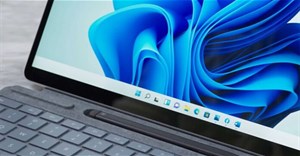Microsoft explains why the clock on the Windows 11 taskbar does not display seconds
Have you ever wondered why the clock area located at the bottom right corner of the screen, on the taskbar (taskbar) of Windows 10, 11 does not display up to seconds? To be fair, most of us just need to capture time as hours and minutes simultaneously. However, in some situations, you may want the Windows clock to display accurate to seconds.
In fact, Windows 10 allows you to display seconds on the taskbar if you are willing to use tricks to interfere and edit the registry. But unlike Windows 10, Windows 11 does not support an optional registry key that allows the taskbar clock to display such seconds. It can be caused by a number of possible software compatibility and performance issues that affect performance.
“Please note, at this time, displaying seconds in flyout is not supported. However, your interest in this has been noted and will be carefully considered in the future,” Microsoft noted in a Feedback Hub post.
In the past, the first versions of Windows (released in the 90s) supported displaying seconds in the taskbar. However, this feature was later made optional in the stable release because it led to some performance issues for users. It sounds strange, but the performance impact in this case was noticeable because PC systems of the time possessed only about 4MB of RAM.
The question is that most modern systems today have at least 4 to 8GB of RAM, so why doesn't Microsoft still have the option to support seconds display on Windows by default? The reason is still performance, Microsoft explained in a new post on the developer blog.
The thing is that even though system memory is no longer a primary concern, the frequent updates needed to support the taskbar seconds display can still make a user's device slower than usual.
Consider a configuration that supports multiple users, such as a terminal server. In servers that support multiple users, the system will attempt to update the taskbar clock once a second so that each logged-in user has their own clock that shows the correct time. As a result, displaying extra seconds puts a significant strain on the system, increasing CPU usage. In fact, many server administrators often disable the taskbar clock completely to reduce the load on the processor.

The same situation applies to systems other than terminal servers, including your personal computer. In a nutshell, Windows will need to spend extra time updating the clock, and the “routine operation” will prevent the CPU from going into a low-power state, which in turn affects overall performance.
It's not clear how Microsoft will deal with this. But it will probably be a long time before Windows 11 users have an option to display seconds on the taskbar by default, or maybe never.
Microsoft is planning a deeper integration between Windows 11 and Android
Hackers fake Windows 11 download page to spread malicious code
10 interesting hidden features of Windows 11
OneDrive is about to become the default folder in File Explorer on Windows 11
- Choose the best configuration management tool for your business
- Essentials on Hitachi Content Platform (HCP) Data Protection and Security
- When used Software as a Security nightmare: The risks of collaboration in the cloud
- About this webinar | Features and instructions for using Webinar
- How to use Webinar in business | Webinar Story 2019
Operate and exploit advertising by iCOMM Vietnam Media and Technology Joint Stock Company.
116 Thai Ha, Trung Liet Ward, Dong Da District, Hanoi.
Email: info@more.edu.vn
Editor in chief: Tran Vo
Tel: (+84) 903076053/7 Fax: (+84) 903030935